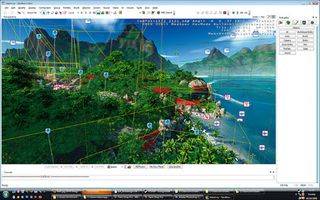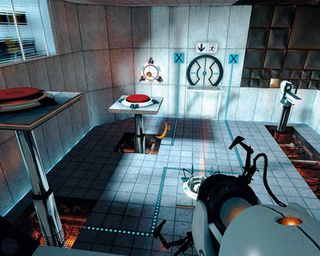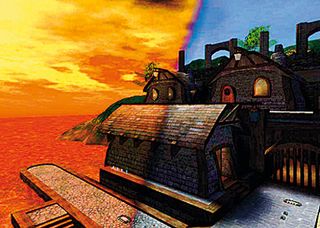The science and art of level design
We examine the evolution and influence of level editors
"The biggest evolution in level editing systems has been driven by a desire to commercialise the product, to make it a licensable application for the production of top-tier games, rather than simply an extension for hobbyists."
People working at home on levels they made for their friends will put up with a lot from a free level editor. But if it's a commercial company that's paying for this stuff, then there have to be big leaps forward.
"This has driven huge improvements in the usability and versatility of the systems," says Alphonso, "which directly reflects the growth and profitability of the industry as a whole. Similar advances have been made in the display and management of the increasingly numerous and complex varieties of assets needed for games, along with advances in scripting the logic that lets the environment function as a game space."
The road is long
Videogames are, of course, inextricably linked with both business and technology. The continuous upward curve of development in tech is something that has driven games forward over time, making them bigger and better, and more complex, at least at a visual level. Compare the first Quake to the most recent shots of Rage, and you'll see what we mean.

Games are a medium in which progress, new stuff, is seen as integral to the experience. This rapid evolution is something that has changed how we create environments for games, even if the experience of playing the games (running about and shooting) and the reality of building the levels (piecing together shapes and making sure they have the appropriate textures on them) have basically continued along in the same direction.
"It's not really changed in ten years," says Rob Hale, a level designer at UK studio Ninja Theory. "However, it's harder to make something now than it was ten years ago." The tools might be shinier, and the product of labour might be more impressive, but the journey is much longer.
Get daily insight, inspiration and deals in your inbox
Sign up for breaking news, reviews, opinion, top tech deals, and more.
It's a point on which Alphonso concurs: "The biggest change in the level design process has come from the changes to the sheer scale of game development teams. Improvements in tools have made things a bit faster and easier to pick up initially, but the bar constantly being raised in terms of quality has meant that the workload hasn't gotten any smaller. Level designers are always the last to assemble the various pieces of content that the rest of the team produces, so with team sizes sometimes now up in the hundreds, improvements have definitely been necessary!"
Problems of scale
Hale goes on to explain to us why the symbiotic nature of business and tech has sometimes been bad for the designer's game craft:
"I've been using Unreal since 2001 and while it's been made easier to import art and put it in levels it's only gotten harder to actually realise a level as a level designer. It involves far more people, far more mark-up and the turn around time is much longer. In fact a lot of the skills that level designers possessed ten years ago are now being lost because of the increased number of people required to deliver on the perceived 'required' quality of a level. Level designers no longer take an interest in the overall look of a level as this is an artists job, while I argue that you cannot separate how a level looks from how it plays. The two are uniquely linked."
Hale has witnessed first-hand the nature of a changing industry. What would have been made by a single guy with a vision ten years ago is now generally built by a team who must agree and work together on the direction of a level. This could potentially lead to a regression in the actual play subtleties of levels.
"Take Unreal Tournament 3 for example," says Hale. "The levels look very lovely but they tend to play really badly. In comparison to the original Unreal Tournament, where each level was generally crafted by a single designer they are much less enjoyable to play often because of the increased detail that has been made possible by modern design tools."
Hale argues that the forward progress of visuals has hampered understanding of what makes a level great, not least because companies are making the same old levels over and over again.
"Level design relies upon the tools your game provides. If your game design doesn't provide your level designers with interesting tools in the games mechanics there isn't much they can do. Mirror's Edge demanded interesting level design because of the games design, as did Portal. If you're going to rehash mechanics that are ten years old you're going to get rehashed levels. There are clearly a few outliers and oddly enough they all do very well at market. Bioshock, Portal, Mirrors Edge all had good level design, but that's three games out of lots and lots."

Different designs
There are plenty of people making stuff who have very different ideas about what level editors are for. Artists like Tom "Nullpointer" Betts, for example, see these as just another tool in an artistic repertoire: "Level editing software allows artists the ability to leverage the power of commercial game engines to realise their own ideas," says Betts.
"For the price of a game you can essentially buy your way into a part of the development chain. Of course, there are limitations to the control you can exert over the overall game mechanics and behaviour, but the trade-off is access to tools and tech that would otherwise take months to build up."
Betts has used modding in gallery art on several occasions: "After working with the source code of Quake I realised that level editing was a much easier way to modify the games I was interested in. QQQ was an art installation based on Quake3 Arena where real time death-matches were re-presented in a hacked version of the client where modified levels and graphics led to a psychedelic flow of glitched imagery. I also used a modified Counter-Strike level in another installation where all the surfaces of the level were texture mapped in real time from CCTV cameras in the gallery, leading to a kaleidoscope of fragmented video."

Another level-editing artist is Alison Mealey, whose UnrealArt project led to some inspired pieces of game-generated art. "The UnrealArt levels ended up as massive empty landscapes. The bots would play, Godlike, a Deathmatch map of my creation. These levels had a complex web of bot paths; the paths when viewed from a distance revealed a line drawing of a face. The idea was that the bots would go about their business killing each other, all the while their movements were being tracked and they were slowly revealing a beautiful, serene, traditional portrait."
Alison set up the level so that bots would produce the data she needed to create beautifully impressionist portraits: "Essentially the final UnrealArt portraits can be seen as a visualisation of the level and the gameplay generated from that level from a top down perspective. It's a little more than that though (or at least I like to think it is), while I was the one who laid down the paths for the bots to walk along, it was them, their situations, their decisions and their movements that actually created the portraits."
But what of the increased complexity of these tools? Doesn't that just make the artist's job harder? "I don't think so," says Mealey. "New technologies aren't scary, intimidating things for artists, you just need to look at it from the perspective of what does this new tool do, and is it something I can use to make my own lovely things."
The lesson perhaps, is that creativity will always find a way, as long as we can provide the tools. The past ten years has seen the game industry create a toolkit that was unimaginable twenty years ago. What we do with it in the coming decade will be up to us.
-------------------------------------------------------------------------------------------------------
First published in PCFormat Issue 234
Liked this? Then check out Past, present and future of the demoscene
Sign up for TechRadar's free Weird Week in Tech newsletter
Get the oddest tech stories of the week, plus the most popular news and reviews delivered straight to your inbox. Sign up at http://www.techradar.com/register












